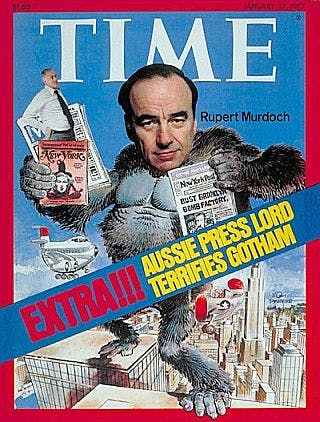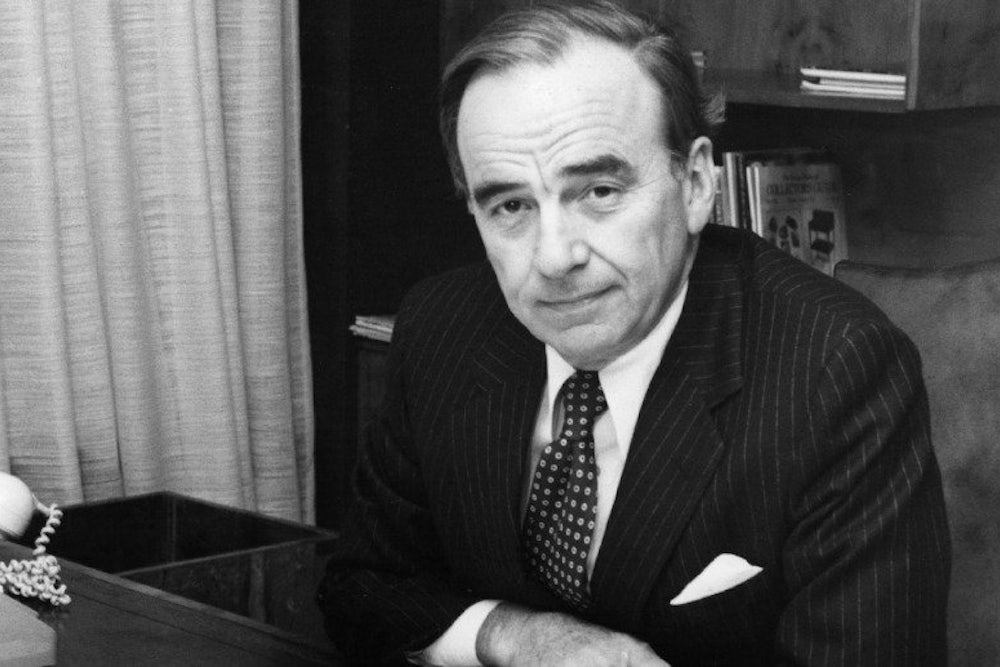Amid reports that Rupert Murdoch is stepping down as head 21st Century Fox, his historical status as one of America’s most notorious press lords is secure. As owner of The Wall Street Journal and creator of Fox News, he ranks in the same league as William Randoph Hearst and Joseph Pulitzer. Yet looking back on his career, it’s remarkable both how recent his foothold in America is, and how shaky it initially was.

In 1977, when Murdoch bought New York magazine and The Village Voice, he faced a fierce staff revolt, one that left its mark on the billionaire owner. In 2011, more than a quarter century after he sold the alternative weekly, Murdoch described the Voice as “the bane of my existence.” A Time magazine cover from Jan 17, 1977, portrayed Murdoch as King Kong astride the Empire State Building, with a blaring headline reading "EXTRA!!! AUSSIE PRESS LORD TERRIFIES GOTHAM."
Yet despite the resistance he met, Murdoch’s early American foray prefigured his larger ambitions for remaking the media landscape. As journalist Jack Doyle noted in an article on PopHistoryDig.com, “By today’s standards, his 1976-77 New York acquisitions seem tame. Yet these deals, and the changes Murdoch undertook with them at the time, shook things up in the media print world and hinted at his grander plans ahead.”
Before his entry into the crucial New York City media market, Murdoch had been confined to publications far removed from the Big Apple. In 1973, he bought the San Antonio Express and the San Antonio Evening News. Murdoch moved to the United States the following year, starting up The National Star, a tabloid weekly in the manner of The National Enquirer. In 1976, he purchased the New York Post, then a liberal daily.
But it was Murdoch’s acquisition of New York and the Voice that spread journalistic alarm, since both publications adhered to values that were more inimical to the right-wing populist than even the Post. Under founder Clay Felker, New York was the Mecca of the New Journalism, the magazine that gave a forum for writers like Tom Wolfe, Nora Ephron, and Gail Sheehy to do novelistic reporting that changed the rules for non-fiction. Meanwhile the Voice was the thriving hotbed of New York radicalism, the venue where crucial debates about feminism and gay rights received a mainstream airing. Neither publication seemed in sync with Murdoch’s political and journalistic agenda.
Clay Felker initially approached Murdoch in the mid-1970s hoping that the Australian press lord would help him in his struggles with the Board of Directors of New York Magazine Co. But, as Felker soon discovered, Murdoch didn’t just want a share of the company but a controlling interest. Felker’s loyal staff supported him in the ensuing power struggle, and at one point threatened mass resignation. This led Murdoch’s lawyers to tell the staff that they were “furniture” in the deal and not crucial for the magazine.
Such was the bad feeling in the feud with Felker that Murdoch seems to have commissioned a roman à clef to get revenge. In 1979, the gossip columnist Neal Travis, a longtime Murdoch employee, published a trashy best-seller called Manhattan, about a press baron’s hostile takeover of a magazine called Manhattan. In the novel, the Clay Felker character is named Mike Glennon, portrayed as an amoral louse who neglects his wife, seduces his niece, and puts his magazine in hock to the mafia. The implicit message of Manhattan was that Murdoch was doing everyone a favor by taking New York magazine away from the noxious Felker.
The legendary Voice columnist Nate Hentoff once told Murdoch that “you are the most effective labor organizer I’ve ever known about.” Hentoff and a small number of other staffers had been trying unsuccessfully to start a union for many years. Almost immediately after Murdoch took control of the paper, it unionized in 1977. The quick unionization was the start of a fractious period when Murdoch and the staff repeatedly clashed.
Murdoch eventually divested control of both New York and the Voice, finding more compatible employees at Fox News. Yet in his early purchases, it was already clear that Murdoch would be a polarizing figure, a man with great power who from the start was seen as a threat to journalistic values.
